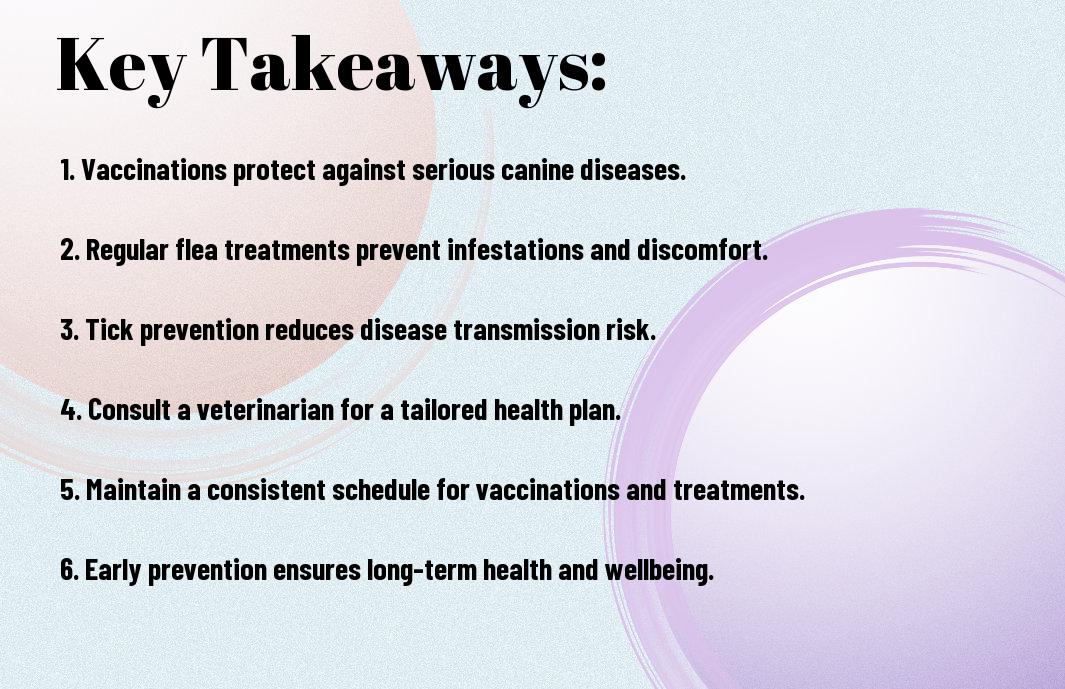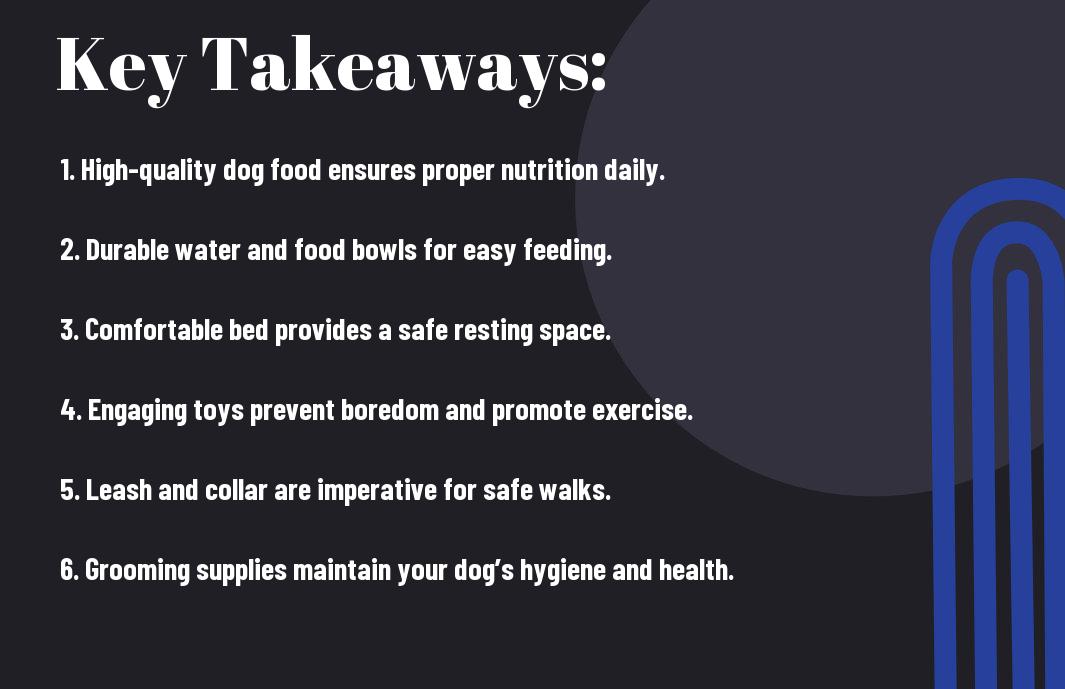Vaccinations play a vital role in keeping your dog healthy and protecting them against serious diseases. Alongside vaccinations, implementing effective flea and tick prevention measures is crucial for safeguarding your pet from harmful parasites that can cause discomfort and transmit diseases. In this blog post, you will learn about the types of vaccinations your dog needs, the importance of regular flea and tick prevention, and practical tips to ensure your furry companion stays happy and healthy throughout their life.

Understanding Preventative Care
Definition and Importance of Preventative Care
Understanding preventative care for your dog is vital for ensuring their long-term health and wellbeing. Preventative care encompasses a range of practices, including vaccinations, regular check-ups, and preventive treatments that aim to avert diseases before they develop. By prioritizing preventative strategies, you not only safeguard your pet’s health but also save on potentially high vet bills associated with treating illnesses that might have been avoided.
The importance of preventative care goes beyond just preventing illnesses; it contributes to your furry friend’s overall quality of life. Regular visits to the veterinarian can lead to early detection of health issues, allowing for prompt interventions. As a responsible pet owner, investing time and resources in preventative care is a beneficial choice that fosters a healthier and happier life for your dog.
The Role of Vaccinations in Preventative Care
Role of vaccinations in preventative care cannot be overstated. Vaccinations are vital tools in protecting your dog from potentially severe or life-threatening diseases. By providing immunity against common infections, such as parvovirus, rabies, and distemper, vaccinations help ensure that your pet remains healthy and free from these preventable illnesses. Most veterinarians recommend a vaccination schedule based on your dog’s age, lifestyle, and overall health condition, helping you stay informed and proactive about your pet’s health.
In addition, keeping your dog up to date on vaccinations is vital for your community’s health. By ensuring that your pet is vaccinated, you not only protect them but also contribute to herd immunity, which helps mitigate the risk of disease outbreaks. Regular vaccination can also lead to fewer vet visits and associated costs, underscoring the importance of maintaining a proactive approach to your dog’s preventative care.
The Role of Flea and Tick Prevention
Along with vaccinations, flea and tick prevention plays a significant role in your dog’s overall health. These parasites can transmit a variety of diseases that may adversely affect not only your pet but also your family. Implementing a reliable flea and tick prevention strategy protects your dog from infections like Lyme disease and ehrlichiosis, which can lead to serious health issues. Regular use of preventive medications can effectively keep these pests at bay, ensuring your dog remains comfortable and healthy.
Careful consideration of flea and tick prevention should also extend to your home and yard. By maintaining a clean environment and using appropriate treatments, you can reduce the likelihood of infestations that could impact your dog’s health. As a pet owner, proactive flea and tick management enhances your dog’s quality of life, allowing them to enjoy their time outdoors without the risk of dangerous bites or infections.
Canine Vaccinations
While the joy of having a dog comes with various responsibilities, one of the most important is ensuring their health through proper vaccinations. Vaccinations play a significant role in protecting your pet from severe diseases and infections that can impact their quality of life. By keeping your dog’s vaccinations up to date, you not only support their well-being but also help to prevent the spread of contagious diseases in the canine population.
Core Vaccinations for Dogs
By focusing on core vaccinations, you can safeguard your dog against the most common and severe diseases. Core vaccinations are recommended for all dogs, regardless of their lifestyle or environment. These include vaccines for rabies, distemper, parvovirus, and adenovirus. Ensuring your dog receives these necessary shots helps to build immunity and keeps them safe from highly contagious and potentially fatal illnesses.
These core vaccines are typically administered in a series during your dog’s puppyhood, with boosters given later in life to maintain immunity. It’s advisable to consult with your veterinarian to develop a vaccination plan tailored to your dog’s specific needs and risk factors.
Non-Core Vaccinations
For some dogs, non-core vaccinations may also be necessary based on individual factors such as geographic location, lifestyle, and potential exposure to certain pathogens. Vaccines such as Bordetella (to prevent kennel cough), Lyme disease, and leptospirosis are categorized as non-core vaccines. These vaccinations are excellent options if your dog frequently interacts with others, enjoys outdoor activities, or resides in areas where these diseases are prevalent.
Consequently, non-core vaccinations should not be overlooked, as they can provide an additional layer of protection for your dog in specific circumstances. It’s necessary to discuss your dog’s activities and lifestyle with your veterinarian to determine which non-core vaccines may be appropriate for their health and safety.
Vaccination Schedules
Rabies vaccinations are typically mandated by law in many regions, making it imperative for you to stay engaged with your dog’s vaccination schedule. Your veterinarian will provide a timeline for core and non-core vaccines based on your dog’s age and medical history. Generally, the series of core vaccinations begins when your dog is a puppy and includes a booster at one year and subsequent boosters every three years thereafter.
This schedule can vary depending on factors such as your dog’s specific needs, lifestyle changes, and age. Regular check-ups with your veterinarian will ensure that your dog remains up to date on vaccinations and receives any necessary boosters, which is vital for their long-term health and protection against illness. Always consult your vet to keep track of your dog’s vaccination schedules and make any necessary adjustments as they grow and their environment changes.
Flea Prevention
Now that you understand the importance of preventative care for your dog, let’s explore into flea prevention. Fleas are not just a nuisance; they can cause significant health issues for your pet, including skin irritations, anemia, and even the transmission of diseases. By proactively managing and preventing flea infestations, you can keep your furry friend comfortable and healthy. This begins with understanding how fleas live and reproduce.
Understanding Flea Life Cycle
Among the first steps in effective flea prevention is understanding the life cycle of fleas, which consists of four stages: egg, larva, pupa, and adult. Adult fleas are the ones you typically see on your dog and can lay hundreds of eggs in a short time. These eggs can fall off your dog and settle in your home, yard, or other environments, where they will hatch into larvae and eventually develop into pupae before maturing into adult fleas.
By knowing this life cycle, you can realize that simply treating your dog for fleas isn’t enough. Unless you also tackle the environment where flea eggs and larvae may be hiding, you’ll likely find yourself in a continuous cycle of infestation. This highlight provides insight into why a comprehensive flea prevention strategy is necessary for your dog’s well-being.
Flea Prevention Strategies
On top of understanding the flea life cycle, it’s important to utilize effective flea prevention strategies. Regular use of flea prevention products, such as topical treatments and oral medications, can create a protective barrier for your dog. Additionally, maintaining a clean environment by vacuuming frequently and washing your dog’s bedding can help eliminate any potential flea eggs or larvae hiding within your home.
Understanding the various options available for flea prevention will allow you to select the best strategy for your dog’s needs. Regular checks for fleas, especially after outdoor excursions, can also be invaluable. Consult your veterinarian about the best products suited for your dog’s specific lifestyle and breed, ensuring that you are using the most effective methods to keep your furry companion flea-free.
Treating Flea Infestations
Among the many responsibilities of being a pet owner is knowing how to effectively treat a flea infestation should it occur. If you spot fleas on your dog, acting swiftly is imperative to mitigate suffering for both your pet and your home environment. Begin by bathing your dog with a flea shampoo that kills adult fleas and then follow up with prescribed medications from your veterinarian to eliminate any remaining pests in your dog’s system.
In addition to treating your dog, you’ll need to focus on your home. Thoroughly vacuum carpets, rugs, and upholstery to remove eggs and larvae, and wash all bedding in hot water. This dual approach will give you the best chance of eradicating fleas effectively. Maintaining consistent prevention methods afterward will help ensure fleas don’t return.
Medications such as topical treatments or oral flea preventatives can offer effective solutions for both immediate treatment and long-term prevention. Always consult with your veterinarian to determine which options are safe and appropriate for your specific dog breed and health conditions, making sure you provide the right care for your beloved pet. By staying proactive in your flea management efforts, you can enhance your dog’s quality of life and keep infestations at bay.

Tick Prevention
Keep your dog safe from ticks by understanding the risks and implementing prevention strategies. Ticks are more than just a nuisance; they can transmit various diseases that may seriously impact your furry friend’s health. In areas where ticks are prevalent, ensuring your dog is protected from these parasites becomes crucial in maintaining their overall well-being.
Understanding Tick-Borne Diseases
Diseases transmitted by ticks can range from mild to severe, affecting both your dog and, potentially, your family. Common tick-borne diseases include Lyme disease, ehrlichiosis, and anaplasmosis. Each of these illnesses has distinct symptoms, but they often start with fever, lethargy, and loss of appetite in dogs. If not addressed promptly, tick-borne diseases can lead to long-term health issues, making prevention vital.
Being aware of the specific diseases present in your area can help you take targeted precautions. Ticks thrive in grassy and wooded environments, and they can latch onto your dog during outdoor activities. Keeping your dog protected against these harmful pests is crucial for their health and happiness.
Tick Prevention Strategies
At the heart of effective tick prevention is a multi-faceted approach. Using veterinarian-recommended tick preventatives is an crucial step. These products can come in the form of topical treatments, collars, or oral medications that repel or kill ticks before they can attach. It’s important to choose a product that is suitable for your dog’s age, size, and health status.
Additionally, you should consider keeping your yard well-maintained to make it less inviting for ticks. Regularly mowing the lawn, removing debris, and creating barrier zones with rocks or gravel can help reduce tick populations. Be mindful of where you take your dog for walks and try to avoid areas known to have high tick activity.
It’s wise to follow a routine that includes tick prevention methods along with regular consultations with your veterinarian. They can offer tailored advice and ensure that your dog receives the best protection possible.
Regular Tick Checks and Removal
Tick prevention doesn’t end with treatments; regular tick checks are equally important. When you return home from walks or outdoor activities, take time to inspect your dog’s fur, skin, and areas where ticks commonly hide, such as around the ears, under the collar, and between the toes. Early detection is key to minimizing any potential health risks.
In the unfortunate event that you do find a tick, it’s crucial to remove it promptly and correctly. Use fine-tipped tweezers to grasp the tick as close to your dog’s skin as possible, pulling it straight out. Ensure the entire tick, including the head, is removed to prevent infection. If you’re unsure about the removal process or see any complications afterward, don’t hesitate to contact your veterinarian.
Treatments such as topical solutions can provide both a protective barrier and a way to kill ticks on contact. It’s crucial to follow your vet’s guidelines for application and re-treating your dog regularly for sustained effectiveness.
Integrating Preventative Care into Routine
Your dog’s health is best supported through a consistent approach to preventative care. By incorporating vaccinations, flea, and tick prevention into your regular routine, you create an environment where your dog can thrive. Establishing solid practices can simplify your pet care journey while significantly improving their overall well-being.
Establishing a Care Schedule
Among the most effective strategies you can adopt is creating a care schedule that aligns with your dog’s individual needs. This schedule should account for vaccination appointments, flea treatments, and check-ups, ensuring that you don’t miss important preventive measures. You might want to consider setting reminders on your phone or using a calendar specifically dedicated to your pet’s health.
Furthermore, consistency in your routine is key. Take note of your dog’s age, breed, and any pre-existing health conditions when formulating your schedule, as these factors can heavily dictate the frequency of preventive care needed. Being proactive is an crucial part of ensuring the long-term health of your furry companion.
Working with Your Veterinarian
With a trusted veterinarian by your side, you can tailor your preventative care routine to best suit your dog’s needs. Open communication with your vet allows you to stay informed on the latest recommendations for vaccinations and preventative treatments specific to your area and your dog’s lifestyle. Your vet can play a vital role in identifying the most effective products and practices for maintaining your dog’s health.
Hence, be sure to schedule regular vet appointments where you can discuss any concerns or changes you’ve noticed in your dog. As a partner in your dog’s health care, your veterinarian can provide insights based on their expertise and the latest veterinary research, ensuring you stay ahead of potential health issues.
Monitoring Your Dog’s Health
With a well-established care schedule and a good relationship with your veterinarian, you should also prioritize monitoring your dog’s health on a day-to-day basis. This involves observing changes in behavior, energy levels, or eating habits, which can often indicate underlying health issues. Familiarize yourself with your dog’s normal patterns so that you can spot any deviations early on.
Consequently, incorporating regular check-ins into your routine can help you catch any health concerns before they escalate. For example, a simple weekly health assessment could include checking for fleas and ticks, inspecting their skin for irritations, and keeping an eye on their weight. The more in tune you are with your dog’s health, the better you will be able to respond to their needs promptly.

Myths and Misconceptions
Once again, the discussion around preventative care for dogs brings forth a variety of myths and misconceptions that can mislead you regarding your pet’s health. It’s vital to clarify these inaccuracies to ensure that you’re making the most informed decisions about vaccinations, flea, and tick prevention for your furry companion.
Common Myths About Vaccinations
To begin with, many pet owners believe that once their dog receives its initial vaccinations, there’s no need for annual boosters. This belief is misleading, as vaccines can lose their effectiveness over time. Regular booster shots help maintain your dog’s immunity against serious diseases, ensuring their continued protection. Additionally, some might think that vaccinating their dog is unnecessary if they primarily stay indoors. However, even indoor dogs can be exposed to potentially harmful pathogens through various means, such as visitors, other animals, or the environment.
To further complicate the matter, there are misconceptions surrounding the safety and side effects of vaccinations. While it’s true that some dogs may exhibit mild side effects after vaccination, most reactions are not severe, and the benefits of vaccination far outweigh the risks. Consulting with your veterinarian can help you understand the specific vaccinations that are appropriate for your dog and alleviate any concerns you might have.
Myths About Flea and Tick Prevention
Myths about flea and tick prevention can also lead to inadequate care for your dog. Many people assume that their pets will not get fleas or ticks if they live in a clean environment or don’t spend much time outdoors. This is not entirely accurate, as fleas and ticks can thrive in various settings and latch onto your dog during any outdoor outing. Additionally, some individuals may believe that home remedies or occasional treatments are sufficient to prevent infestations. This notion can result in a lack of adequate protection, leaving your pet vulnerable to infestations and potential diseases.
Hence, it’s important to employ a consistent and comprehensive flea and tick prevention plan. Regular use of veterinarian-recommended products and treatments, along with maintaining cleanliness in your dog’s environment, can effectively minimize the risk of these parasites. This approach ensures that your dog remains safe and healthy throughout the year. Taking these proactive steps will help you provide the best possible care for your four-legged friend.
Conclusion
Considering all points, you can significantly enhance your dog’s health and quality of life through preventative care. Vaccinations serve as the first line of defense against various infectious diseases, providing your pet with imperative protection. In conjunction with regular vaccinations, implementing a flea and tick prevention regimen ensures that your furry friend remains comfortable and free from harmful parasites that can lead to serious health issues. Staying proactive in these areas is not only beneficial for your dog’s well-being but also helps to minimize potential healthcare costs down the line.
By prioritizing these preventative measures, you are making a responsible and informed choice for your dog’s health care. Regular check-ups with your veterinarian, coupled with timely vaccinations and preventative treatments, will empower you to keep your pet safe and thriving. Ultimately, your commitment to preventative care will pave the way for a longer, healthier, and happier life for your beloved dog.
Q: What are the core vaccinations recommended for dogs?
A: Core vaccinations for dogs typically include rabies, distemper, parvovirus, and adenovirus (hepatitis). These vaccines are imperative to protect against widespread and severe diseases that can threaten a dog’s health. Puppies usually start their vaccination series between six to eight weeks of age and continue until they are around 16 weeks old, followed by booster shots as recommended by a veterinarian throughout their life.
Q: How often should I administer flea and tick prevention to my dog?
A: The frequency of flea and tick prevention greatly depends on the type of product used. Some topical treatments are applied once a month, while oral medications may need to be given monthly or every three months. It’s important to consult with your veterinarian to choose the right prevention method and schedule based on your dog’s lifestyle, environment, and health status.
Q: What are the signs that my dog may have fleas or ticks?
A: Common signs that your dog may have fleas include excessive scratching, biting at the skin, hot spots, or visible flea dirt (small black specks that resemble pepper) on their coat. Ticks can be detected by examining your dog for small, oval-shaped, grayish-brown pests attached to the skin. Other symptoms of tick infestations may include lethargy, loss of appetite, or unusual behaviors. If you suspect your dog has fleas or ticks, it’s recommended to consult with a veterinarian for proper diagnosis and treatment.










